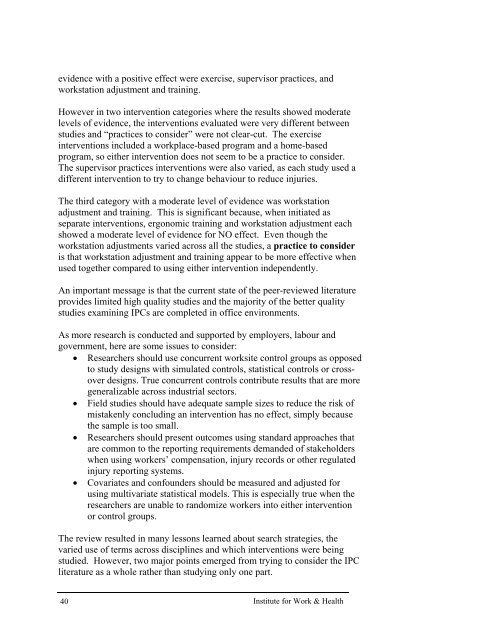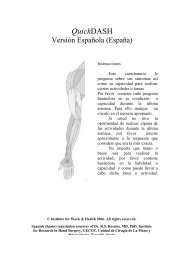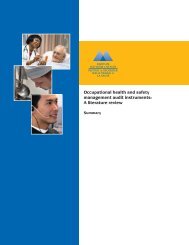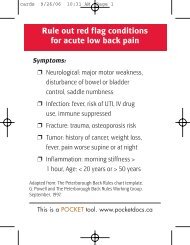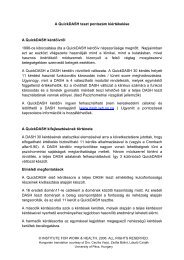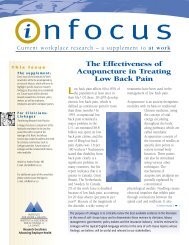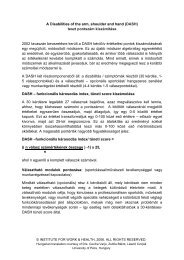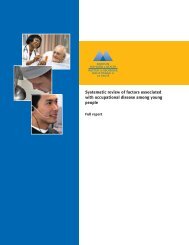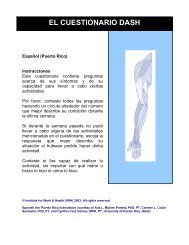A systematic review of injury/illness prevention and loss control ...
A systematic review of injury/illness prevention and loss control ...
A systematic review of injury/illness prevention and loss control ...
- No tags were found...
Create successful ePaper yourself
Turn your PDF publications into a flip-book with our unique Google optimized e-Paper software.
evidence with a positive effect were exercise, supervisor practices, <strong>and</strong>workstation adjustment <strong>and</strong> training.However in two intervention categories where the results showed moderatelevels <strong>of</strong> evidence, the interventions evaluated were very different betweenstudies <strong>and</strong> “practices to consider” were not clear-cut. The exerciseinterventions included a workplace-based program <strong>and</strong> a home-basedprogram, so either intervention does not seem to be a practice to consider.The supervisor practices interventions were also varied, as each study used adifferent intervention to try to change behaviour to reduce injuries.The third category with a moderate level <strong>of</strong> evidence was workstationadjustment <strong>and</strong> training. This is significant because, when initiated asseparate interventions, ergonomic training <strong>and</strong> workstation adjustment eachshowed a moderate level <strong>of</strong> evidence for NO effect. Even though theworkstation adjustments varied across all the studies, a practice to consideris that workstation adjustment <strong>and</strong> training appear to be more effective whenused together compared to using either intervention independently.An important message is that the current state <strong>of</strong> the peer-<strong>review</strong>ed literatureprovides limited high quality studies <strong>and</strong> the majority <strong>of</strong> the better qualitystudies examining IPCs are completed in <strong>of</strong>fice environments.As more research is conducted <strong>and</strong> supported by employers, labour <strong>and</strong>government, here are some issues to consider:• Researchers should use concurrent worksite <strong>control</strong> groups as opposedto study designs with simulated <strong>control</strong>s, statistical <strong>control</strong>s or crossoverdesigns. True concurrent <strong>control</strong>s contribute results that are moregeneralizable across industrial sectors.• Field studies should have adequate sample sizes to reduce the risk <strong>of</strong>mistakenly concluding an intervention has no effect, simply becausethe sample is too small.• Researchers should present outcomes using st<strong>and</strong>ard approaches thatare common to the reporting requirements dem<strong>and</strong>ed <strong>of</strong> stakeholderswhen using workers’ compensation, <strong>injury</strong> records or other regulated<strong>injury</strong> reporting systems.• Covariates <strong>and</strong> confounders should be measured <strong>and</strong> adjusted forusing multivariate statistical models. This is especially true when theresearchers are unable to r<strong>and</strong>omize workers into either interventionor <strong>control</strong> groups.The <strong>review</strong> resulted in many lessons learned about search strategies, thevaried use <strong>of</strong> terms across disciplines <strong>and</strong> which interventions were beingstudied. However, two major points emerged from trying to consider the IPCliterature as a whole rather than studying only one part.40 Institute for Work & Health


